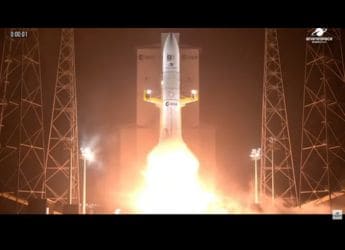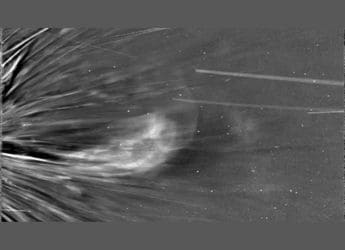- Home
- Science
- Science News
- Hubble Discovers White Dwarf Merger Remnant with Unusual Carbon Signature
Hubble Discovers White Dwarf Merger Remnant with Unusual Carbon Signature
Astronomers discovered WD 0525+526, a massive white dwarf formed from a stellar merger.

Photo Credit: NASA, ESA, STScI, Ralf Crawford (STScI)
Hubble study reveals rare white dwarfs may be more common
An international team of astronomies just announced the discovery of a cosmic oddity: A white dwarf star measuring up to 2.27 solar masses as a result of a white dwarf merging with another star, rather than from the thermonuclear fusion which underpins the majority of white dwarfs. This finding, made using sensitive ultraviolet observations with NASA's Hubble Space Telescope, indicates it is possible these rare white dwarfs are far more widespread than initially thought. The star, known as WD 0525+526, is approximately 128 light-years from Earth. This research is described in a paper published Aug. 6 in the journal Nature Astronomy.
Star with an Unusual Past
According to the paper, WD 0525+526 is what is known as a white dwarf, the superdense core of a star of a type similar to our Sun. In visible light it looked totally unremarkable at first, but its chemical makeup was a different story.
The observatory's powerful ultraviolet tools discovered in the star's atmosphere an even higher surge of carbon than astronomers had expected, suggesting that some previous violent disruption of the star had nearly stripped away its hydrogen-helium layers, exposing the secretly carbon-enriched core.
The aftermath left WD 0525+526 unusually hot and massive for a white dwarf: it now has roughly 1.2 times the mass of the Sun and a surface temperature of around 21,000 K, all crammed into what's basically an Earth-sized ball. These characteristics make WD 0525+526 a rare merger remnant as opposed to a more standard white dwarf.
Understanding stellar evolution
WD 0525+526 appeared completely normal in visible light until it was observed by Hubble's powerful ultraviolet instruments. This has led the astronomers to think that many more white dwarfs could be hiding similar explosive origins.
"We would like to extend our research on this topic by exploring how common carbon white dwarfs are among similar white dwarfs, and how many stellar mergers are hiding among the normal white dwarf family," Antoine Bedrad, a researcher at the University of Warwick who co-led the study, said in a statement. "That will be an important contribution to our understanding of white dwarf binaries, and the pathways to supernova explosions."
Get your daily dose of tech news, reviews, and insights, in under 80 characters on Gadgets 360 Turbo. Connect with fellow tech lovers on our Forum. Follow us on X, Facebook, WhatsApp, Threads and Google News for instant updates. Catch all the action on our YouTube channel.
Related Stories
- Samsung Galaxy Unpacked 2025
- ChatGPT
- Redmi Note 14 Pro+
- iPhone 16
- Apple Vision Pro
- Oneplus 12
- OnePlus Nord CE 3 Lite 5G
- iPhone 13
- Xiaomi 14 Pro
- Oppo Find N3
- Tecno Spark Go (2023)
- Realme V30
- Best Phones Under 25000
- Samsung Galaxy S24 Series
- Cryptocurrency
- iQoo 12
- Samsung Galaxy S24 Ultra
- Giottus
- Samsung Galaxy Z Flip 5
- Apple 'Scary Fast'
- Housefull 5
- GoPro Hero 12 Black Review
- Invincible Season 2
- JioGlass
- HD Ready TV
- Laptop Under 50000
- Smartwatch Under 10000
- Latest Mobile Phones
- Compare Phones
- OnePlus 15R
- Realme Narzo 90x 5G
- Realme Narzo 90 5G
- Vivo S50 Pro Mini
- Vivo S50
- OPPO Reno 15c
- Redmi Note 15 5G
- Redmi Note 15 Pro 5G
- Asus ProArt P16
- MacBook Pro 14-inch (M5, 2025)
- OnePlus Pad Go 2
- Poco Pad M1
- Just Corseca Skywatch Pro
- Honor Watch X5
- Acerpure Nitro Z Series 100-inch QLED TV
- Samsung 43 Inch LED Ultra HD (4K) Smart TV (UA43UE81AFULXL)
- Asus ROG Ally
- Nintendo Switch Lite
- Haier 1.6 Ton 5 Star Inverter Split AC (HSU19G-MZAID5BN-INV)
- Haier 1.6 Ton 5 Star Inverter Split AC (HSU19G-MZAIM5BN-INV)

















